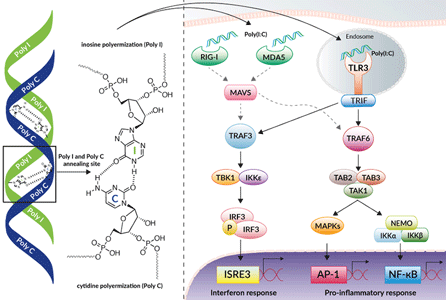歡迎您來到深圳欣博盛生物科技有限公司網(wǎng)站!
歡迎您來到深圳欣博盛生物科技有限公司網(wǎng)站!
更新時間:2022-01-28
Polyinosinic-polycytidylic acid (i.e. poly(I:C)) is a synthetic analog of double-stranded RNA (dsRNA), a molecular pattern associated with viral infection. InvivoGen’s Poly(I:C) LMW (Low Molecular ……
Polyinosinic-polycytidylic acid (i.e. poly(I:C)) is a synthetic analog of double-stranded RNA (dsRNA), a molecular pattern associated with viral infection. InvivoGen’s Poly(I:C) LMW (Low Molecular Weight) is comprised of short strands of inosine poly(I) homopolymer annealed to strands of cytidine poly(C) homopolymer. The average size of Poly(I:C) LMW is 0.2 kb to 1 kb. Poly(I:C) LMW is functionally validated for TLR3 potency using HEK-Blue™ TLR3 Cells and the absence of contaminants (e.g. lipoproteins and endotoxin) is confirmed using TLR2 and TLR4 cellular assays, respectively.

General Poly(I:C) structure and signaling pathway
Poly(I:C) is structurally similar to dsRNA, present in some viruses, and is therefore commonly used to model the actions of extracellular dsRNA.
Upon binding to its receptors, poly(I:C) is able to selectively activate numerous signaling pathways depending on the conditions. Poly(I:C) is recognized by endosomal Toll-like receptor 3 (TLR3) [1, 2]. Upon recognition, TLR3 activates the transcription factor interferon regulatory factor 3 (IRF3), through the adapter protein Toll-IL-1 receptor (TIR) domain-containing adapter (TRIF, also known as TICAM-1) [3]. Activation of IRF3 leads to the production of type I IFNs (e.g. IFN-β). Additionally, recognition of poly(I:C) can lead to the recruitment of TNF receptor-associated factor 6 (TRAF6) or receptor-interacting protein 1 (RIP1), with the subsequent activation of the transcription factors NF-κB and AP-1 [4]. Activation of these pathways triggers the production of inflammatory cytokines and chemokines such as TNF-α, IL-6, and CXCL10. Furthermore, poly(I:C) may activate the cytosolic RNA helicases retinoic acid-inducible protein I (RIG-I) and melanoma differentiation-associate gene 5 (MDA-5) [5].
Due to its ability to induce signaling via multiple inflammatory pathways, poly(I:C) is known to increase vaccine immunogenicity, especially in formulations that target dendritic cells. It has been shown that the superior qualities of poly(I:C) as a vaccine adjuvant may be due to synergy between TLR3 and MDA-5 activation [6].
Activator of TLR3
Functionally validated
Rhodamine-labeled poly(I:C) (LMW) is also available
References:
1. Alexopoulou L. et al., 2001. Recognition of double-stranded RNA and activation of NFkappaB by Toll-like receptor 3. Nature, 413(6857):732-8.
2. Matsumoto M. et al., 2002. Establishment of a monoclonal antibody against human Toll-like receptor 3 that blocks double-stranded RNA-mediated signaling. BBRC, 293(5):1364-9.
3. Yamamoto M. et al., 2003. Role of Adaptor TRIF in the MyD88-Independent Toll-Like Receptor Signaling Pathway. Science 301: 640.
4. Kawai T & Akira S., 2008. Toll-like receptor and RIG-I-like receptor signaling. Ann N Y Acad Sci. 1143:1-20. Review.
5. Kato H. et al., 2006. Differential roles of MDA5 and RIG-I helicases in the recognition of RNA viruses. Nature. 441(7089):101-5.
6. van den Boorn, J.G. et al. 2012. Nucleic acid adjuvants: toward an educated vaccine. Adv Immunol 114, 1-32.
CAS number: 31852-29-6
Working concentration: 30 ng - 10 μg/ml
Solubility: 20 mg/ml in physiological water (NaCl 0.9%)
Quality Control:
Absorbance spectrum
TLR3 activity has been verified using HEK-Blue™ TLR3 cells
The absence of bacterial contamination (e.g. lipoproteins and endotoxins) has been confirmed using HEK-Blue™ TLR2 and HEK?Blue™ TLR4 cells.
Poly(I:C) LMW is provided lyophilized and with sterile endotoxin-free physiological water (NaCl 0.9%).
It is available in two quantities:
25 mg (#tlrl-picw) with 10 ml of sterile endotoxin-free physiological water
250 mg (#tlrl-picw-250) with 2 x 25ml of sterile endotoxin-free physiological water
![]() Poly(I:C) LMW is shipped at room temperature
Poly(I:C) LMW is shipped at room temperature
![]() Upon receipt store at 4°C. Upon resuspension, prepare aliquots and store at -20°C for long term storage. Store at 4°C for short term storage.
Upon receipt store at 4°C. Upon resuspension, prepare aliquots and store at -20°C for long term storage. Store at 4°C for short term storage.
![]() Lyophilized product is stable 1 year at 4°C when properly stored.
Lyophilized product is stable 1 year at 4°C when properly stored.
![]() Resuspended product is stable 1 month at 4°C and 1 year at -20°C.
Resuspended product is stable 1 month at 4°C and 1 year at -20°C.
![]() Avoid repeated freeze-thaw cycles.
Avoid repeated freeze-thaw cycles.
如需購買或咨詢該產(chǎn)品技術問題,請聯(lián)系Invivogen一級代理商-欣博盛生物